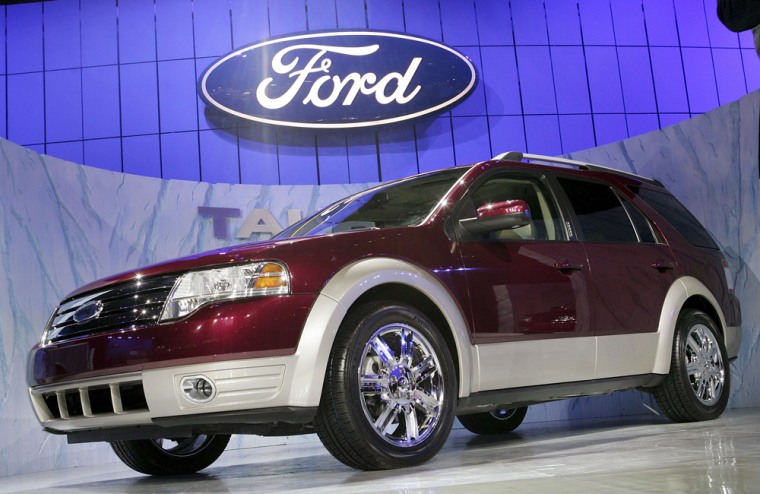Driving safe doesn't have to mean being bound to some grocery-getter mom-mobile.
Honda Pilot owners might attest to that. The Pilot has the silhouette of a traditional truck-based sport utility vehicle, yet it has safety and handling attributes that are much more in line with a minivan or tall wagon. It's also one of the most manageably sized vehicles, with a third row of seating. What's more, side-curtain airbags are standard and cover all three rows.
The Pilot is one of a handful of 2008 models that meet demand for striking yet secure drives. Last year a Consumer Reports survey found that 12 percent of new-car shoppers ranked safety their top consideration. That's enough of a critical mass to bring plenty of safe choices — as demonstrated by our varied list, ranging from economical to lavish, staid to sporty.
But whether you opt for a sedan, wagon, minivan or sport utility vehicle depends on how many people and on what kind of trips you'll be taking, says Anne Fleming, spokeswoman for the Insurance Institute for Highway Safety (IIHS), an organization that represents the interests of the insurance industry.
Body style aside, the set of experts we asked say that the safest vehicles for family use are those with electronic stability control, side-curtain airbags for all rows, and good crash-test results. There's also another factor you might not think of right away: reliability. Being stranded on the side of the road, even if you're in the safest vehicle available, can put you and your family at a much higher risk.
And risk, according to Michael Dulberger, president of the consumer advocacy group Informed for Life, is the way to look at the entire task. He recommends finding the safest vehicle for family use by assessing the overall risk to occupants, which he says is indicated by a number of factors, including top IIHS and National Highway Traffic Safety Administration crash-test ratings, good side-impact protection (including airbags), the presence of electronic stability control and a low propensity to roll over (indicated by a high NHTSA rollover star rating).
Once you've established low risk, Dulberger says, you should also make sure that the vehicle you're considering is rated five stars in the federal side crash test for rear occupants and also has head-protecting side-curtain airbags.
For families seeking optimal safety features such as these, automotive experts say the four-door midsize or large car is a near-sure bet. That's because most large sedans have good crash-test ratings, low death rates and low insurance claim rates, says Fleming, which means that injury rates generally are low too.
But what if you're in the market for an SUV or a minivan? David Champion, director of automotive testing at Consumer Reports, says to look for models that do very well in crash tests and have secure handling. Most sport utility vehicles, even if they're so-called crossover vehicles with car-based underpinnings, have a higher likelihood to roll over, which increases risk and often counters the additional protection they might provide. Wagons, Champion says, offer the secure handling of sedans along with interior space that, in some models, rivals SUVs.
If it's extra passenger space you need, you'll find there's no shortage of new SUV or minivan models offering third-row seating that often expands capacity to seven or eight — provided the rearmost occupants are small and limber. But with some of them positioned nearly to the back of the vehicle, there's reason to be wary that they might not provide the same protection of the other rows.
Your best bet here is to "make absolutely sure that the side bags extend to that third seat," says Fleming, since they provide valuable head protection in side impacts.
A word of caution: Champion says there's very little fatality data to determine exactly how safe these arrangements are, but he adds that manufacturers have to comply with the same regulations for backrests, head restraints and seat belts. What's more, he says that with the folding-seat arrangements on many SUVs and minivans, it's easy to forget to put the headrests back into position.
Champion advises that shoppers consider what they really need, versus what they think they might someday need. For instance, going off-road or towing a boat once in a while might not justify the safety sacrifices — let alone the fuel bills — of a less-stable truck-based SUV.
If you need to use a child seat, Fleming cautions that not all vehicles will work well with all restraints. She recommends that if you're attached to a particular one, you should take it with you when vehicle shopping.
In order to find the safest family cars, we compiled a list of vehicles — sedans, wagons, minivans and SUVs — that have earned top five-star rankings for both driver and passenger in the federal (NHTSA) crash tests for frontal impact, along with top five-star rankings for both the front seat and rear seat in NHTSA side impact tests.
Of those all-stars, we looked at IIHS crash test results for overall frontal offset, side and rear protection, and eliminated any models that scored, where tested, anything less than the top "good" rating. Then we weeded out any vehicles that don't offer electronic stability control, keeping those for which it's either standard or optional. We then considered reliability, disqualifying several vehicles that are rated below average in Consumer Reports' reliability ratings. Finally, we reordered and ranked the vehicles remaining based on the wealth of positive crash-test info available, and on overall Environmental Protection Agency interior volume to form our list.
